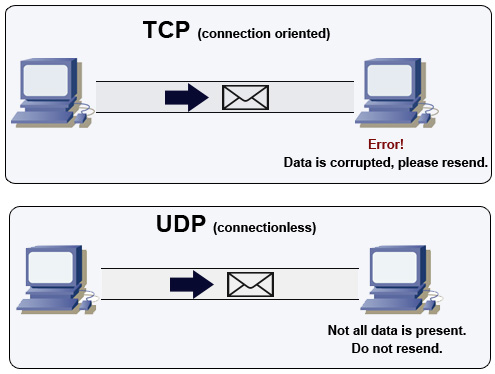In this tutorial you will learn about difference between TCP and UDP.
TCP
TCP stands for Transmission Control Protocol. This is one of the main protocols of the Internet protocol suite. TCP is a connection – oriented protocol that provides a reliable flow of data communication between two computers. That means from source to destination all information in both ways must be reached. So TCP connection – oriented protocol establishes a communication link between a source port/IP address and a destination port/IP address. The ports are bound together via this link until the connection is terminated and the link is broken. An example of connection – oriented protocol is a telephone conversation. A telephone connection is established, communication takes place and finally connection terminated.
UDP
UDP stands for User Datagram Protocol. This is connection less protocol. It sends independent packets of data (we call these independent packets as datagrams) from one computer to other computer. But this not guarantees that data arrival. So this is not reliable communication. Those who not require strict reliable communication, and who feels that reliable communication gives more overhead, such place UDP is very useful.
One best example where UDP is required is, when a clock server sends the current time to its client when requested. Suppose the packet is missed in way. In reliable communication same packet re-sends again. But here it makes no sense that sending same packet, because it shows wrong time. Here TCP is not required. UDP is required.

TCP vs UDP – Difference between TCP and UDP
| TCP | UDP |
| 1) Connection-oriented protocol. | 1) Connection-less protocol. |
| 2) Reliable communication. | 2) Not reliable communication. |
| 3) TCP implements connection as a stream of bytes form source to destination. | 3) UDP sends independent packets called datagrams from source to destination. |
| 4) No loss of data, order of delivery are considerable. | 4) Order of delivery, no loss of data are not guaranteed. |
| 5) Reliability is important than speed. | 5) Speed is important than reliability. |
| 6) TCP header size is 20 bytes | 6) UDP header size is 8 bytes |
| 7) TCP follows 3 – way handshake for connection establishment. | 7) No handshake is required, since it is connection less protocol. |
| 8) Since reliable communication is necessary in this, TCP uses error – detection and error – correction mechanisms for erroneous packets. | 8) No error – checking, no error – detection. It simply discards the packet if it corrupted. |
| 9) There is acknowledgement for each byte. So we called TCP is a byte – stream protocol. | 9) No acknowledgement. |
| 10) Flow control, congestion control happen in TCP | 10) No flow control or congestion control. |
| 11) Each byte assigned with a sequence number. | 11) No sequence number for packets. |
| 12) Example: making a phone call. | 12) Example: Playing online games. |
| 13) TCP is required for such protocols that, HTTP, HTTPs, FTP, SMTP, Telnet etc. | 13) UDP is required for such protocols that, DNS, DHCP, SNMP, RIP, VOIP, TFTP etc. |
Comment below if you have queries related to above tutorial for udp vs tcp.
The post Difference between TCP and UDP appeared first on The Crazy Programmer.
from The Crazy Programmer https://www.thecrazyprogrammer.com/2018/01/difference-tcp-udp.html
Comments
Post a Comment